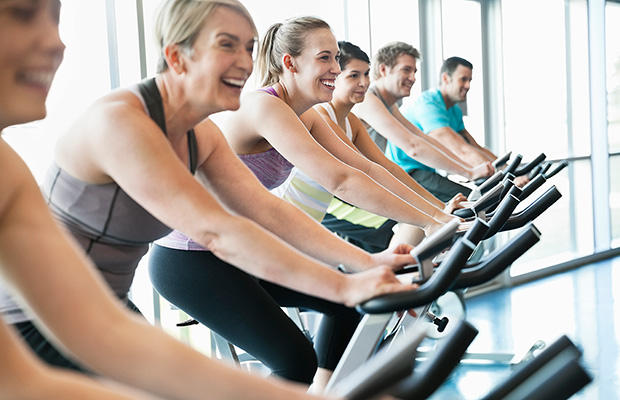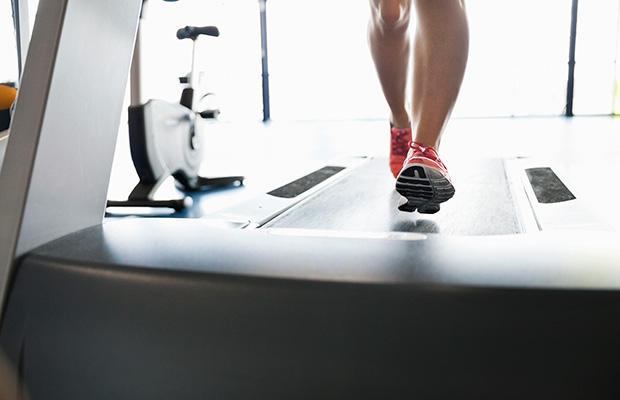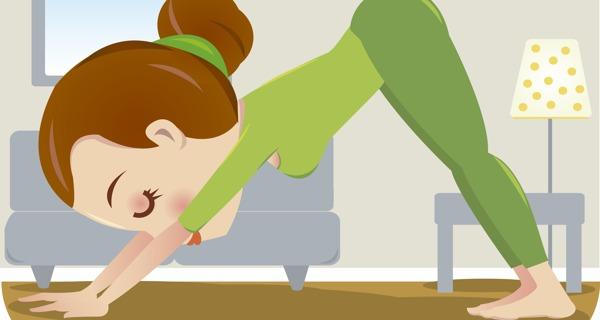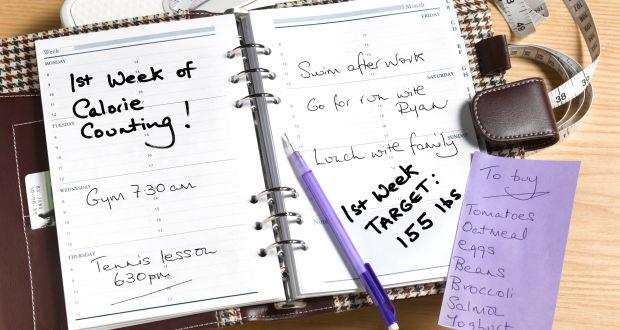Like cardio, strength training burns calories while you're doing it, but lifting also comes with benefits that last far longer, Blakely says. The more muscle mass you have, the higher your resting metabolism, which means you'll burn more fat even when you're just sitting on the couch. What's more, strong muscles promote good form during your run, hike, or spin class, protecting you from injury and helping you reap bigger benefits from your sweat sessions, says Allison Hagendorf, a certified health coach with the American Council on Exercise.
2. And heavier weights net you even bigger results.
Functional body-weight moves like push-ups, squats, and lunges make everyday activities like lifting groceries or climbing stairs easier, Hagendorf says. Reaching for heavier dumbbells—those you can lift for only 8 to 15 reps—can stimulate the type of lean-mass production that truly transforms your body. "For someone who has never done weights, they may find they have a better body in their 40s than they did in their 30s when they start strength training regularly," says Liz Neporent, a trainer and fitness expert in New York.
Don't fret about bulking up—unless you're spending hours at the gym and pounding down massive quantities of protein, it just won't happen. In fact, resistance training essentially "shrink-wraps" your body, tightening and firming you in all the right places, says Hagendorf. Your clothes will fit more loosely and you'll look slimmer, even before the number on the scale budges. (Keep up the good fitness work with a plan made for your crazy schedule; in just 10 minutes a day, you can transform your body with Prevention's Fit in 10 DVD!)
3. The best workout won't deliver without upgrades to your kitchen routine.
 Photograph by David Jakle/Getty Images
Photograph by David Jakle/Getty Images
They may not use corporate-speak like "synergy" and "touching base offline," but trainers have their own sayings. Among the most popular: "You can't out-train a bad diet," says Samantha Clayton, a former Olympic sprinter and personal trainer in Malibu, CA.
Your workout can complement your initial weight loss efforts and help maintain a new, slimmer physique. University of Alabama researchers recently studied women who lost 25 pounds. Those who did strength training and cardio three times per week offset the slowdown in metabolism that typically occurs after you shed pounds, staving off regain, according to the study published in Medicine & Science in Sports & Exercise.
However, you'll have to change your eating habits to see significant changes to your body in the first place. "Even if you're doing everything right in the gym, if you aren't eating to optimize your training, you're never going to get the results you want," Hagendorf says. Start with small changes—one less packet of sugar in your coffee, a side salad with your lunch. Keep that up for 2 weeks, and then pick two more minor adjustments. Eventually, you'll build a nutritious and sustainable diet, says Liz LeFrois, a personal trainer in New York and a fitness expert on the streaming fitness site Acacia TV.
4. But addition can be better than subtraction.
Though you do have to watch what you eat, obsessive or near-starvation diets don't work in the long run. Cutting too many calories breaks down the muscles you're working so hard to build up, Clayton says. You may shed a few pounds at first by skipping meals or eliminating entire food groups, but the second you return to a regular eating plan, your beaten-down body and slowed metabolism actually trigger excess weight gain.
Focus on what to add to your diet instead of what to take away. Piling more high-quality, nutrient-rich foods like fruits, vegetables, seeds, and nuts onto your plate provides your body with the fuel to tackle your workouts while also improving your overall health, Blakely says. (These five food combos will make your healthy diet even healthier.) You'll feel fuller on fewer calories, and over time—about 6 months, to be precise—you'll actually rewire your brain to crave healthy foods instead of junk, according to a recent study in the journal Nutrition & Diabetes.
5. In the recipe for success, fun is an essential ingredient.
 Photograph by Hero Images/Getty Images
Photograph by Hero Images/Getty Images
Trainers have a rep for working you so hard you puke. Not only are such extreme efforts unnecessary for weight loss, they may be counterproductive both physiologically and psychologically. If you actively dread your workouts, it's all too easy to make excuses to skip them, says Mike Robinson, of MZR Fitness in San Luis Obispo, CA, recognized as 2015 personal trainer of the year by the IDEA Health and Fitness Association.
Meanwhile, many pastimes that bring you joy—like gardening, hiking, or dancing—count as physical activity, too. Incorporating them into your plan means you'll actually look forward to exercise, getting you into a regular routine and melting fat with much less effort. "Many people think exercise has to be very difficult and complicated to yield results," Clayton says. "They are pleasantly surprised to find out that it's balance and consistency that improves your body."
6. The other 23 hours of the day count, too.
Regardless of whether you're sweating with a trainer or on your own, a successful weight loss program requires an all-day approach to movement, Blakely says. You might not think things like fidgeting during a meeting or tapping your toe along with the car radio could truly make a difference. A landmark study in the journal Science found otherwise, calculating that small tweaks in daily activity patterns could help heavy people torch an extra 350 calories per day.
The scientific term for this phenomenon is non–exercise activity thermogenesis—in other words, all the calories you burn just going about your day. So while you're probably sick of hearing about parking farther away from the grocery store and taking the stairs instead of the escalator, trainers know their most successful clients take this type of advice to heart.
7. Getting fit isn't actually that much harder than staying heavy.
 Photograph by Hero Images/Getty Images
Photograph by Hero Images/Getty Images
Yes, you will have to put some work into achieving your weight loss goals. But consider all the energy you currently expend wishing you had a different body and fretting about how you don't have the time or energy to make a change. Trainers know the true secret to changing your body is shifting your attention away from what you don't have and toward what you can achieve. "You just have to choose which one you want to put your energy into," says Robinson. "Firmly commit and put your mind to losing the weight and your body will follow."
8. Weight loss isn't your true goal.
Often, people starting a new exercise program begin because they're unhappy with what they see in the mirror. But a good trainer will ask you to drill down deeper. "Just keeping asking yourself the question 'Why?' " Blakely advises. Often, the fourth or fifth answer reveals your true motivation.
Take Blakely's experience: "As I get to know the client, I'll find they're not going on vacations with friends because they know they can't do the hike or the excursion as comfortably as they want. Or they're not as spontaneous as they want to be because they know that their building is under construction and it's overwhelming that now they have to walk a certain length to get somewhere," she says.
Clarifying these higher-level goals—even writing them down and sticking them to your mirror or fridge—can give you the motivation to stick to your plan in the face of temptation, Hagendorf says. Plus, you can often detect progress even before you start to see big aesthetic or weight changes. "The feel is the fuel," Blakely likes to say; if you notice you're not as fatigued, winded, or frightened of new challenges, you'll know you're on the right track regardless of what the scale says.
 Photograph by Hero Images/Getty Images
Photograph by Hero Images/Getty Images



